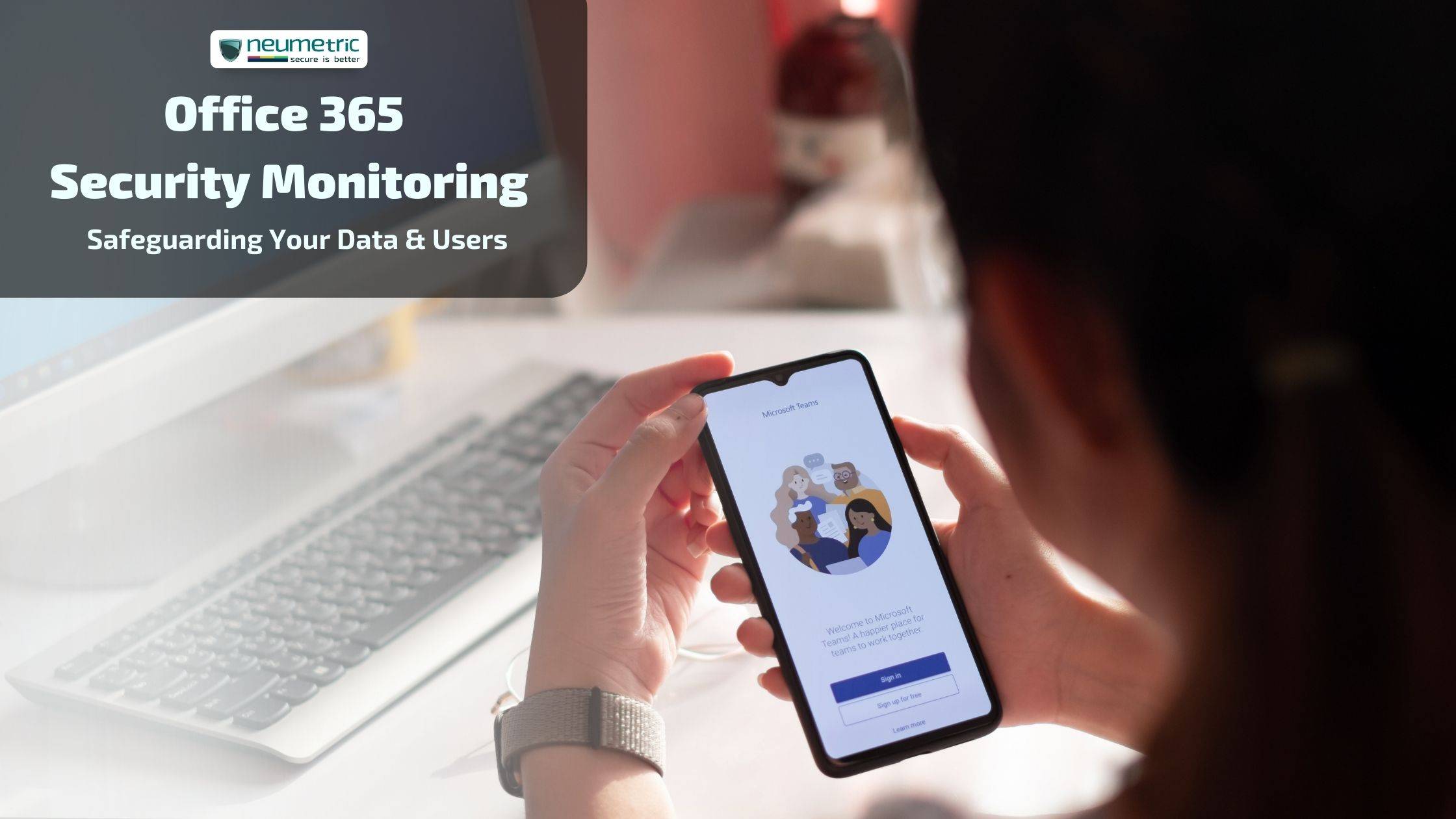Table of Contents
ToggleOffice 365 Security Monitoring: Safeguarding Your Data & Users
Introduction:
Office 365 has emerged as a cornerstone of productivity & collaboration for businesses globally in today’s fast expanding digital landscape. However, this convenience comes at the expense of a critical need for strong security measures. This Journal will go into the vital world of Office 365 Security Monitoring, providing light on its importance, fundamental capabilities & role in assuring data security & regulatory compliance.
The proactive process of tracking, identifying & mitigating security risks & threats within the Office 365 system is known as Office 365 Security Monitoring. It is a collection of technologies, processes & rules aimed to protect sensitive data, user accounts & communication channels against a wide range of cyber attacks.
Cyberattacks have increased in the digital age, ranging from data breaches to ransomware attacks. With so many organizations relying on Office 365 for communication, collaboration & storage, protecting this ecosystem has become critical. Breach not only jeopardizes sensitive corporate data, but also erodes customer trust & causes financial & reputational harm.
The primary goal of this Journal is to educate businesses on the importance of Office 365 security & to provide best practices that can help them protect their digital operations. Organizations can traverse the complicated security landscape & keep one step ahead of potential attacks by knowing & following these practices.
Understanding Office 365 Security Features:
Office 365 includes a number of sophisticated security capabilities that serve as the first line of defense against threats:
Multi-Factor Authentication [MFA]: This additional layer of security forces users to give numerous forms of authentication before accessing accounts, reducing the risk of illegal access dramatically.
Data Loss Prevention [DLP]: These systems scan incoming data for sensitive information & prevent illegal dissemination, reducing the risk of data leaks.
Malware & phishing protection: Advanced threat protection systems detect & neutralize malware & phishing efforts, protecting users from dangerous information.
Encryption & rights management: These capabilities protect data at rest & data in transit & enable enterprises to govern who has access to & shares sensitive information.
Office 365 Security is critical for businesses working in regulated industries to ensure compliance with data protection standards such as GDPR, HIPAA & others. Organizations can ensure they satisfy the strict criteria of these standards by installing the essential security measures, avoiding expensive penalties & legal repercussions.
Office 365 security monitoring tools:
Office 365 security & compliance center: The Office 365 Security & Compliance Center is the command center for managing security & compliance throughout the Office 365 infrastructure. It provides an extensive dashboard from which administrators may create security policies, monitor compliance & investigate any breaches. This unified center enables enterprises to identify & address security problems proactively.
Unified audit log & activity reports: The Unified Audit Log keeps track of user & administrator activity across all Office 365 services. This record contains extensive information on who accessed what data, when & from where. Activity reports provide visual summaries of user activities, allowing managers to discover suspect or unauthorized behaviors promptly. This technology is critical for ensuring organizational openness & accountability.
Advanced threat analytics [ATA] & Cloud access security broker [CASB]: This uses machine learning to detect aberrant network behavior, assisting in the identification of possible threats before they escalate. Cloud Access Security Broker [CASB] extends similar security to cloud services such as Office 365, allowing for real-time monitoring of data traveling into & out of cloud apps. These tools improve threat detection capabilities, allowing for a more proactive defense against emerging cyber threats.
Third-party security monitoring solutions: While Office 365 includes a powerful set of security capabilities, some businesses want to supplement their security posture with third-party solutions. These solutions frequently provide specialized features, increased threat intelligence & seamless integration with Office 365, adding an extra layer of security tailored to individual needs.
Key aspects of office 365 security monitoring:
Effective security monitoring entails paying close attention to user activity & access patterns. Administrators can keep track of who logs in, who accesses files & who makes changes in the Office 365 environment. This aids in the detection of any unauthorized or unexpected conduct that may signal a security compromise.
Anomalous activity can suggest unwanted access attempts, such as abrupt surges in failed login attempts or anomalous data access from strange places. Behavioral analytics are used by security monitoring solutions to detect such patterns, allowing administrators to respond quickly & prevent potential intrusions.
Monitoring data sharing & cooperation is critical given the collaborative nature of Office 365. External file sharing can be monitored by security measures, ensuring that critical information does not end up in the wrong hands.
External dangers, such as phishing efforts & malware, pose serious concerns. Threat intelligence-capable security monitoring software may analyze incoming emails & URLs, detecting potentially harmful information. This preventive strategy lowers the likelihood of becoming a victim of phishing assaults & malware infections.
Office 365 security monitoring best practices:
The activation & proper configuration of Office 365’s built-in security measures is the cornerstone of security. This involves enabling threat protection methods to detect & mitigate potential malware & phishing attacks, implementing Multi-Factor Authentication [MFA] for all users, establishing Data Loss Prevention [DLP] policies to prevent inadvertent data breaches & implementing Multi-Factor Authentication [MFA] for all users.
Setting up alerts & notifications is critical for detecting threats in real time. Administrators should set thresholds & criteria to trigger alerts when odd actions occur, such as several failed login attempts or a significant increase in data access from unfamiliar places. This guarantees that security professionals are notified of potential breaches as soon as possible, allowing for a speedy response.
Security audits & assessments on a regular basis aid in identifying vulnerabilities & weaknesses in the Office 365 security plan. These assessments should take into account user access entitlements, external sharing settings & compliance adherence. Organizations can resolve security flaws before they are exploited by conducting frequent assessments.
Human mistake continues to be a substantial contributor to security vulnerabilities. Organizations must spend in training their staff about recommended practices for Office 365 security. This training should cover issues including spotting phishing attempts, data classification & using secure communication methods. A well-informed staff functions as an extra line of defense against cyber dangers.
Real-time incident response & remediation:
A well-defined incident response workflow is critical in the case of a security occurrence. This comprises determining the breadth & impact of the incident, containing its consequences, eliminating the threat & finally recovering affected systems & data. A well-defined & tested plan provides a quick & effective response.
A thorough investigation is required to determine the nature of the incident. To assess the entry point, propagation & impact of a breach, security professionals must examine logs, audit trails & activity reports. This information informs the following measures & aids in the prevention of similar situations in the future.
Once the issue has been identified, suitable corrective actions can be implemented. This may entail isolating compromised accounts, removing harmful files or patching vulnerable systems. Furthermore, preventive steps such as refining security rules, updating security configurations & improving user training should be implemented to bolster defenses against such instances.
Organizations may develop a strong Office 365 security monitoring framework by following these best practices. This framework not only helps with proactive threat identification, but it also provides a quick & effective reaction to security occurrences. Continuous improvement & adaptation of these practices are critical to ensuring the integrity of Office 365 environments & safeguarding sensitive data & operations as the threat landscape evolves.
Office 365 security monitoring for remote & hybrid work environments:
The rise of remote & hybrid work styles presents new security problems. Employees accessing Office 365 resources from several places & devices might broaden the attack surface, necessitating the monitoring & security of endpoints outside of traditional office networks. Furthermore, the possibility of combining personal & business devices raises the risk of data leakage & unauthorized access.
Organizations must alter their Office 365 security monitoring practices to address these concerns. This includes fine-tuning access controls to accommodate for remote & hybrid work circumstances, putting geo-fencing in place to block access from unfamiliar regions & regularly monitoring endpoints for signs of compromise. It is critical to provide ongoing user education regarding safe remote work practices, highlighting the need of using VPNs, secure Wi-Fi connections & adhering to MFA standards.
Furthermore, the use of specialist technologies such as Cloud Access Security Broker [CASB] becomes critical for monitoring data transfer across several devices & networks. Real-time alerts & behavioral analytics can detect anomalous behaviors, allowing for quick reactions to possible risks.
Office 365 security updates & future trends:
Microsoft continues to invest in improving Office 365 security, recognizing the critical role it plays in safeguarding businesses’ digital assets. Regular upgrades strengthen existing features while also introducing new capabilities to combat emerging threats. Advanced threat detection algorithms, enhanced user access controls & seamless interaction with threat intelligence feeds are all part of these enhancements. The idea is to give users the tools they need to keep up with growing cyber threats.
The cyber threat landscape is always changing. Organizations must remain adaptive in their security strategies as attackers develop new approaches. To tackle threats such as AI-powered attacks, targeted ransomware & zero-day vulnerabilities, Office 365 security will continue to grow. A greater emphasis will be focused on using artificial intelligence & machine learning to evaluate massive volumes of data, allowing for more proactive threat detection & faster response times.
Conclusion:
Office 365 Security Monitoring has emerged as a critical pillar of protection for enterprises in the fast expanding digital ecosystem. This Journal explored the diverse world of Office 365 security, emphasizing its importance as an essential strategy for protecting data & people. From built-in security measures to real-time incident response, Office 365 Security Monitoring’s comprehension strategy offers a strong defense against a wide range of cyber threats.
As cyber threats become more prevalent, businesses must acknowledge that Office 365 security is no longer an option, but a strategic need. The many case studies demonstrated how careful monitoring can avoid phishing attacks, limit data leaking & lessen the effect of compromised accounts.
Office 365 Security Monitoring serves as a bulwark against potential threats in a world where data breaches & cyberattacks can have far-reaching implications. Businesses may remain ahead of harmful actors by integrating best practices, cutting-edge tools & continual vigilance. Organizations that prioritize Office 365 security not only secure their sensitive information but also develop confidence with stakeholders & customers.
FAQs:
Can Office 365 be monitored?
Yes, Office 365 can be monitored using various built-in tools & third-party solutions to track user activities, access patterns, data sharing & external threats within the platform.
What are the security measures in Office 365?
Office 365 security measures include Multi-factor authentication [MFA], Data Loss Prevention [DLP], threat protection against malware & phishing, encryption & rights management to safeguard data & user accounts
What are the 4 pillars of Microsoft 365 integrated security?
The four pillars of Microsoft 365 integrated security are Identity & Access Management, Threat Protection, Information Protection & Security Management.
What are the 4 aspects of security?
The four aspects of security are Prevention, Detection, Response & Recovery.





